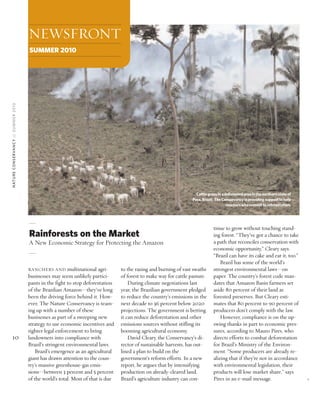More Related Content
Similar to TNC - Brazil (20)
TNC - Brazil
- 1. RANCHERS AND multinational agri-
businesses may seem unlikely partici-
pants in the fight to stop deforestation
of the Brazilian Amazon—they’ve long
been the driving force behind it. How-
ever, The Nature Conservancy is team-
ing up with a number of these
businesses as part of a sweeping new
strategy to use economic incentives and
tighter legal enforcement to bring
landowners into compliance with
Brazil’s stringent environmental laws.
Brazil’s emergence as an agricultural
giant has drawn attention to the coun-
try’s massive greenhouse-gas emis-
sions—between 3 percent and 5 percent
of the world’s total. Most of that is due
to the razing and burning of vast swaths
of forest to make way for cattle pasture.
During climate negotiations last
year, the Brazilian government pledged
to reduce the country’s emissions in the
next decade to 36 percent below 2020
projections. The government is betting
it can reduce deforestation and other
emissions sources without stifling its
booming agricultural economy.
David Cleary, the Conservancy’s di-
rector of sustainable harvests, has out-
lined a plan to build on the
government’s reform efforts. In a new
report, he argues that by intensifying
production on already-cleared land,
Brazil’s agriculture industry can con-
tinue to grow without touching stand-
ing forest. “They’ve got a chance to take
a path that reconciles conservation with
economic opportunity,” Cleary says.
“Brazil can have its cake and eat it, too.”
Brazil has some of the world’s
strongest environmental laws—on
paper. The country’s forest code man-
dates that Amazon Basin farmers set
aside 80 percent of their land as
forested preserves. But Cleary esti-
mates that 80 percent to 90 percent of
producers don’t comply with the law.
However, compliance is on the up-
swing thanks in part to economic pres-
sures, according to Mauro Pires, who
directs efforts to combat deforestation
for Brazil’s Ministry of the Environ-
ment. “Some producers are already re-
alizing that if they’re not in accordance
with environmental legislation, their
products will lose market share,” says
Pires in an e-mail message.
©
10
NATURECONSERVANCY//SUMMER2010
Cattlegrazeinadeforestedareainthenorthernstateof
Para,Brazil. TheConservancyisprovidingsupporttohelp
rancherswhocommittoreforestation.
NEWSFRONT
SUMMER 2010
Rainforests on the Market
A New Economic Strategy for Protecting the Amazon
- 2. WHILE MEXICO’S PARKS and protected areas provide crucial habitat for
species like the jaguar and monarch butterfly, they also bestow a huge eco-
nomic return each year for the country—nearly $3.4 billion—according to a
new report by The Nature Conservancy in collaboration with Mexico’s Na-
tional Protected Areas Commission.
The report estimates that each year Mexico’s protected areas supply as
much as $2.5 billion in captured carbon, $260 million worth of fresh
water, $555 million in tourism spending and more than 25,000 jobs. “For
every dollar invested in protected areas, we found that the country re-
ceives $52 in return,” says Juan Bezaury, the Conservancy’s country repre-
sentative in Mexico.
Bezaury hopes the report’s findings will
encourage increased public funding for con-
servation in Mexico and rally additional sup-
port for protected areas in local communi-
ties. In recent years, the Conservancy has
been working with the National Protected
Areas Commission to create more parks, in-
cluding the 826,000-acre Ocampo protected
area in Coahuila and the 1.3-million-acre
Janos Biosphere Reserve in Chihuahua. Both
were declared protected in 2009.
“Parks are not just an important natural
resource, they are an economic resource
that provides benefits for all Mexicans,”
says Bezaury. “It’s in our economic interest
to invest in these protected areas.” —CURTIS
RUNYAN
ONLINE: Read a summary of the report at: na-
ture.org/mexico
Parks
Provide
Mexico’s Protected
Areas Help Fuel
the Economy
11
NATURECONSERVANCY//SUMMER2010
©
The biggest challenge to full com-
pliance is bringing Brazil’s tens of
thousands of cattle ranchers on board.
They account for 80 percent of the
country’s deforestation. Because most
of the country’s beef is consumed do-
mestically, it is crucial that Brazilian
consumers demand that ranchers act
responsibly, says Pires. “End users have
a crucial role,” he says.
In addition, the Brazilian govern-
ment has begun to step up enforce-
ment, using GPS mapping and satellite
images to track deforestation. “The
salad days of being illegal, of being
fairly sure you were never going to get
busted—that’s all over,” says Cleary.
While Brazil’s government wields
the stick, the Conservancy is “working
more on the carrot side,” says Cleary.
He has been connecting law-abiding
ranchers with environmentally con-
scious buyers and markets. He is also
helping provide financing and techni-
cal support to ranchers and agribusi-
nesses that are committed to
reforestation and using land more effi-
ciently as a means of complying with
the forest code.
There are signs that such conserva-
tion efforts may be working. The de-
forestation rate has declined since
2004, last year hitting its lowest point
since Brazil began tracking it in 1988.
—Ethan Smith
Protectedlands
liketheseinMex-
icoreturnnearly
$3.4billionin
economicvalue
eachyear.
ALTHOUGH FOUND throughout
the Americas, the ocelot is on
the brink of disappearing from
the United States. But rancher
Frank Yturria has given the
species a little breathing room.
Working with The Nature Con-
servancy, Yturria placed 1,300
acres of his Texas ranch—one of two known U.S. locations with breed-
ing ocelots—under a conservation easement, protecting critical cat
habitat forever. —CLAY CARRINGTON
Aradio-collaredocelotisreleasedatLagu-
naAtascosaNationalWildlifeRefuge.
Wild Cats
Ocelot Habitat
Protected in Texas
